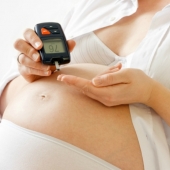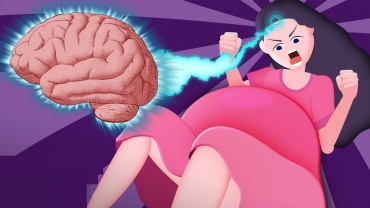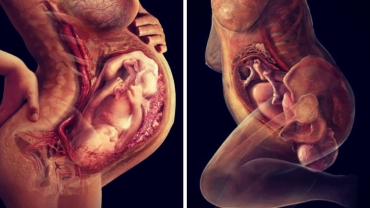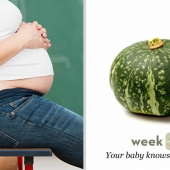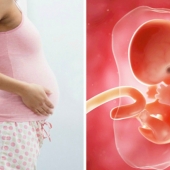You're pregnant. Congratulations! Are you curious how big your developing unborn baby is, what your baby looks like as it grows inside you, and when you'll feel it move?
The start of pregnancy is actually the first day of your last menstrual period. This is called the 'menstrual age' and is about two weeks ahead of when conception actually occurs.
The development stages of pregnancy are called trimesters, or three-month periods, because of the distinct changes that occur in each stage. Take a peek inside the womb to see how a baby develops from month to month.
Month 1
• As the fertilized egg grows, a water-tight sac forms around it, gradually filling with fluid. This is called the amniotic sac, and it helps cushion the growing embryo.
• The placenta also develops. The placenta is a round, flat organ that transfers nutrients from the mother to the baby, and transfers wastes from the baby.
• A primitive face will take form with large dark circles for eyes. The mouth, lower jaw, and throat are developing. Blood cells are taking shape, and circulation will begin. The tiny "heart" tube will beat 65 times a minute by the end of the fourth week. By the end of the first month, your baby is about 1/4 inch long – smaller than a grain of rice!
Month 2
• Your baby's facial features continue to develop. Each ear begins as a little fold of skin at the side of the head. Tiny buds that eventually grow into arms and legs are forming. Fingers, toes and eyes are also forming.
• The neural tube (brain, spinal cord and other neural tissue of the central nervous system) is well formed. The digestive tract and sensory organs begin to develop. Bone starts to replace cartilage.
• The head is large in proportion to the rest of the baby's body.
• By the end of the second month, your baby is about 1 inch long and weighs about 1/30 of an ounce.
• At about 6 weeks, your baby's heart beat can usually be detected.
• After the 8th week, your baby is called a fetus instead of an embryo.
Month 3
• Your baby's arms, hands, fingers, feet, and toes are fully formed. Your baby can open and close its fists and mouth. Fingernails and toenails are beginning to develop and the external ears are formed. The beginnings of teeth are forming. Your baby's reproductive organs also develop, but the baby's gender is difficult to distinguish on ultrasound.
• By the end of the third month, your baby is fully formed. All the organs and extremities are present and will continue to mature in order to become functional. The circulatory and urinary systems are working and the liver produces bile.
• At the end of the third month, your baby is about 4 inches long and weighs about 1 ounce.
• Since your baby's most critical development has taken place, your chance of miscarriage drops considerably after three months.
Month 4
• Your baby's heartbeat may now be audible through an instrument called a doppler. The fingers and toes are well-defined. Eyelids, eyebrows, eyelashes, nails, and hair are formed. Teeth and bones become denser. Your baby can even suck his or her thumb, yawn, stretch, and make faces.
• The nervous system is starting to function. The reproductive organs and genitalia are now fully developed, and your doctor can see on ultrasound if you are having a boy or a girl.
• By the end of the fourth month, your baby is about 6 inches long and weighs about 4 ounces.
Month 5
• You may begin to feel your baby move, since he or she is developing muscles and exercising them. This first movement is called quickening.
• Hair begins to grow on baby's head. Your baby's shoulders, back, and temples are covered by a soft fine hair called lanugo. This hair protects your baby and is usually shed at the end of the baby's first week of life.
• The baby's skin is covered with a whitish coating called vernix caseosa. This "cheesy" substance is thought to protect baby's skin from the long exposure to the amniotic fluid. This coating is shed just before birth.
• By the end of the fifth month, your baby is about 10 inches long and weighs from 1/2 to 1 pound.
Month 6
• Your baby's skin is reddish in color, wrinkled, and veins are visible through the baby's translucent skin. Baby's finger and toe prints are visible. The eyelids begin to part and the eyes open.
• Baby responds to sounds by moving or increasing the pulse. You may notice jerking motions if baby hiccups.
• If born prematurely, your baby may survive after the 23rd week with intensive care.
• By the end of the sixth month, your baby is about 12 inches long and weighs about 2 pounds.
Month 7
• Your baby will continue to mature and develop reserves of body fat. Your baby's hearing is fully developed. He or she changes position frequently and responds to stimuli, including sound, pain, and light. The amniotic fluid begins to diminish.
• At the end of the seventh month, your baby is about 14 inches long and weighs from 2 to 4 pounds.
• If born prematurely, your baby would be likely to survive after the seventh month.
Month 8
• Your baby will continue to mature and develop reserves of body fat. You may notice that your baby is kicking more. Baby's brain is developing rapidly at this time, and your baby can see and hear. Most internal systems are well developed, but the lungs may still be immature.
• Your baby is about 18 inches long and weighs as much as 5 pounds.
Month 9
• Your baby continues to grow and mature: the lungs are nearly fully developed.
• Your baby's reflexes are coordinated so he or she can blink, close the eyes, turn the head, grasp firmly, and respond to sounds, light, and touch. Baby is definitely ready to enter the world!
• You may notice that your baby moves less due to tight space. Your baby's position changes to prepare itself for labor and delivery. The baby drops down in your pelvis. Usually, the baby's head is down toward the birth canal.
• Your baby is about 18 to 20 inches long and weighs about 7 pounds.
- 62416 views

